 |
||
|
||
| ||
Silicon Integrated Systems has excellent (speedy, flawless and inexpensive) chipsets for Socket 370 (SiS 635) and Socket A (SiS 735) platforms. It was the first company to develop workable products for DDR333 high-performance platforms - Socket 423/478 and Socket A. If earlier SiS chipsets were just average solutions for cheap office computers, now we have highly efficient chipsets for home and multimedia PCs. And today we are going to examine a comparatively new product - SiS 645 chipset with DDR333 support for the Intel Pentium 4 platform. We had a good attitude towards this chipset from the very beginning because 635 and 735 made us believe in this company. However, it also means high requirements. Let's see whether the products meets them. And first of all, let me show what functions SiS offers. SiS 645 chipsetSo, the new SiS chipset: for Pentium 4, with DDR333 (PC2700) support. The first thing that catches your eye is that there is more than one chip.  The SiS 645 architecture look classical: two bridges coupled with a high-speed bus and an LPC Super I/O chip for operation with FDD, COM- and LPT-ports etc. It should be noted that a link of the both chips of the north and south bridges in the SiS 645 doesn't differ in functions from one-chip models - SiS 635 and SiS 735. Let's start with bridges, and the first one to be considered is a north bridge. The processor bus controller allows working with Pentium 4 CPUs of any design (Socket 423/478, 100 MHz FSB, 400 MHz resulting frequency at the expense of the Quad-Pumped Bus technology). The memory controller supports PC100/133 SDRAM and DDR333/266/200 SDRAM, thus, providing up to 2.7 GBytes/sec with the latest DDR333 in use. It is obvious that it's useless to combine an aging SDR SDRAM with a powerful Pentium 4. The ECC support is lacking, but I doubt that anyone would assemble servers on the SiS 645. Note that you can insert up to 3 DIMMs of the DDR200/266 and only two DIMMs of the DDR333. The total size is, therefore, 3 and 2 GBytes (as it supports modules of no more than 1 GBytes). The AGP controller doesn't differ from modern counterparts from other manufacturers: it conforms to the AGP 2.0 specification and provides operation of AGP 1x/2x/4x interfaces and the Fast Writes mode. As it was difficult to organize a high-speed data exchange this chipset uses a special transaction coordinator which distributes requests and data streams from a processor to a memory controller, an AGP one and a MuTIOL bus. By the way, a dual-chip solution is an excellent base to test this bus. The coordinator realizes the data pre-fetch mechanism to provide a high speed of reading from memory. The memory controller serves an arbiter for access, queues of instructions and data and an interface of memory access. The arbiter regulates a memory request flow according to a predefined optimized list of request priority which allows changing dynamically priorities either to provide a continuous data flow to the transaction coordinator with minimum delays or to provide data transfer to the device which uses its own channel for the MuTIOL access with a delay not more than 10 microseconds. Before a data access is permitted a respective request is put into a data queue, and an instruction of operation with a page memory mechanism generated for this request is put into an instruction queue. These queues optimize requests to the memory access interface providing a continuous operation with data instead of implementation of instructions of page replacement. 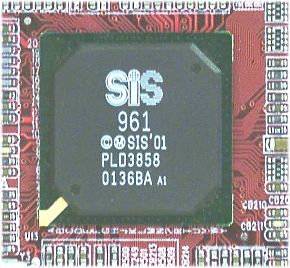 The south bridge (SiS 961 MuTIOL Media I/O) has nothing ground-breaking but it contains everything necessary for a modern chipset:
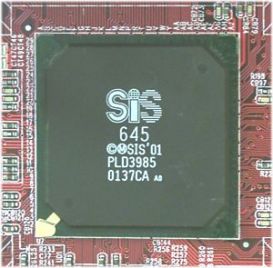 Both bridges are linked with a high-speed bus MuTIOL as the PCI bandwidth is not sufficient. This bus provides a separate memory access channel for each integrated DMA controller (IDE, USB, AC'97 etc.) and for each external PCI device. Requests from all devices are processed by a special SB bus codec which directly connects (via a 16-bit bidirectional data bus with a bandwidth of 266 MBytes/sec in each direction) a similar NB bus codec which readdresses requests to the memory controller. It should be noted that the theoretical total channel width till the codec in the south bridge is 1.2 GBytes/sec, but anyway, 533 (or even 266) MB/sec is too much for modern peripherals. The north bridge of the SiS 645 is enclosed in a 702-pin 37.5 x 37.5 mm BGA case and is based on the 0.18 micron process; it is produced at the SiS's own factory and has a core voltage of only 1.8 V. TestsToday we have widely known chipsets for Pentium 4: Intel i850 (unexcelled in the general performance), Intel i845 and VIA Apollo P4X266, and the today's hero represented by the SiS Reference Board and PCChips m930 board. It should be noted that the DDR333, a trump of the SiS 645, can't be realized on the latter board, contrary to the SiS's reference one. But the diagram will reveal whether the DDR333 is really so necessary for this chipset :) Stands:
Memory: Software:
SiS 645 (SiS Reference Board)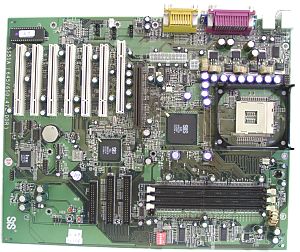 The board is unexpectedly too large (4 cm wider and longer), that is why it doesn't meet the ATX 2.03 specification. The previous Reference Board (on the SiS 735), as you remember, was a bit shorter than specified. Anyway, we will hardly get it on sale, as well as production samples based on it. The board came only with a CD which contains drivers and PDF manuals for the board and chipset. The board is of high quality. It has reset and power buttons. Its dimensions are much more preferable for testers as there are no problems with connection of cables. On the whole, the board remains a mystery as some connectors and switches are not identified. The BIOS is based on the Phoenix 4.0 of the ver.6.0 and offers a great deal of settings for memory timings and chipset registers, and a choice of FSB and memory frequencies. PCChips m930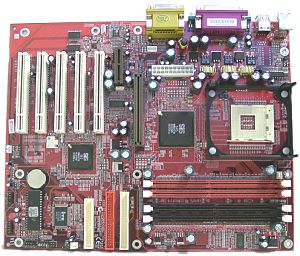 No sooner had SiS released its board as one of its subdivisions launched the first production board on this chipset. Well, first come, first served. The board ships in an OEM package, i.e. with ATA66/100 and FDD cables, a scarce user's manual and a CD with drivers and freeware (WinDVD, MediaRing Talk and PC-Cillin 2000). It is the first board of this trade mark that we have in our lab; earlier we got boards from this company under other trade marks - Elpina or ECS. In general, they are very similar (in particular, in design), but Elpina means the cheapest boards (which are usually yellow), under the PCChips we have more expensive ones (which are red or purple) and ECS boards are black and meant for an average price niche. The board is of high quality, though attached elements are soldered a little carelessly, and the layout is not the best. IDE connectors are too close to memory modules. Audio-ins are right in front of the same PCI slots, and the power supply connector is tucked in between a socket and an AGP slot. At the same time, the board has a connector for audio-outs located on the front computer panel. Moreover, the chipset supports up to 6 USB ports, though the board features only 4 of them - two onboard and two on the backboard. This PCB will serve a base for some other boards as it has unsoldered RJ45 chip and connector and a DVI-out. Its settings can be changed both with a switch (here it is only one - for clearing the CMOS) or in the BIOS Setup. The BIOS is based on the ver.1.21 from AMI. It has all standard settings, as well as a changeable CPU multiplier and a memory frequency - 100 or 133 MHz. It is not much, but the board is primarily meant for the OEM market. At present, this board can help you assemble an Intel Pentium 4 based computer at the lowest sum. ASUS P4T-E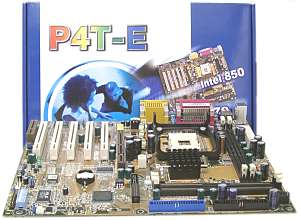 Asustek has redesigned the Asus P4T (meant for Socket 423 ) which was based on the i850. No secret that many manufacturers follow this way to reduce development costs: they leave the general design and change only a layout of electric circuits for a socket. The box offers you a great deal of accessories: a user's manual in English, a short installation manual in 11 languages, 80-conductor ATA66/100, 40-conductor ATA33 and FDD cables, a bracket with two USB ports, 2 C-RIMMs and a CD. The CD has a conventional shell for installation of its programs and drivers. There are such utilities as Adobe Acrobat Reader 5.0, Asus Update, several programs from CyberLink - PowerPlayer SE, PowerDVD (Trial Version), VideoLive Mail; Asus Hotkey, Intel LDCM (LANDesk Client Manager), PCCilllin 2000, Asus PCProbe an Asus's proprietary screensaver. 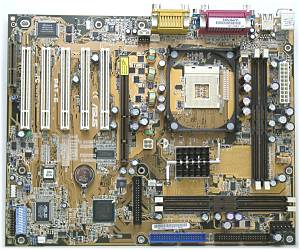 The board much differs in design from its predecessor and from competitors on this chipset. Memory slots flank the socket which is turned at an angle of 90 degrees relative to its usual position. Thus, IDE connectors are moved to the board's edge and an FDD one is at right angle to them, between the memory AGP slots. This connector is made like the AGP Pro, thus allowing us to install professional video cards with increased current consumption. Asus integrated its own monitoring chip - AS99127F. DIP switches can help you adjust a FSB frequency and a CPU multiplier (or you can do it in the BIOS Setup). With other switches you can enable/disable an audio codec, computer startup with USB keyboards and mice and other traditional functions, but for CMOS clearing. The BIOS is based on the v. Medallion from Award and contains a heap of various settings. You can change a FSB frequency in 1 MHz steps from 100 to 227 MHz, a CPU multiplier, a correlation of the memory and FSB frequencies, manually distribute interrupts among PCI slots, adjust settings for AGP, PCI and memory buses. Well, this is one more product from Asus which is speedy and stable enough. VIA PE11-S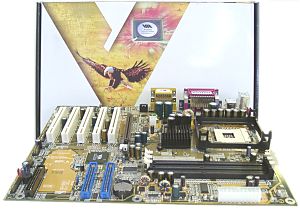 It is the first board in our lab from this vendor. At first sight, it looks very similar to DFI products: a yellow PCB, a plate on the back side to prevent damage, fonts etc.). An austere box has a user's manual of 150 pages in 7 languages, ATA66/100 and FDD cables and a CD. The latter comes only with drivers, an e-version of the manual, PCCillin 2000 and system monitoring utilities. 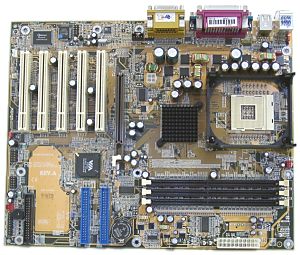 The layout has some disadvantages (IDE and FDD connectors are behind PCI slots, traditional problems with audio-outs) and advantages (high-quality soldering, a clamp for an AGP slot and 13 LowESR capacitors of 2200uF). The PCB can be coupled with some additional devices, for example, this board can have a network controller based on the Realtek chip. Switches can clear the CMOS and start up a computer with the help of PS/2 keyboards and mice etc. The BIOS is based on the v6.00 Modular from AWARD. It offers a lot of settings for memory, AGP and PCI buses, for a CPU multiplier and a FSB frequency. You can also distribute interrupts among PCI slots. In a nutshell, it has excellent speed characteristics and a decent overclocking potential. ABIT BL7-RAID
We have already examined this board earlier that is why our attentive readers can omit several paragraphs below. 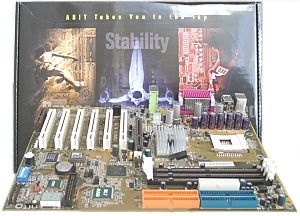 This production sample was packed in a usual dark box. Inside there are such accessories as a user's manual, ATA66/100 and FDD cables, a bracket with a Game-port, a bracket for the rear computer panel, a diskette with drivers for the IDE Raid and a CD with board drivers. Unfortunately, there wasn't a mount for a cooler, that is why we had to use it from another similar board. The CD contains a standard set of Abit's programs: a DVD player - WinDVD, Hardware Doctor, Adobe Acrobat Reader and Buzzsoft's programs - SoftCardManager, SoftCopier, SoftPostCard, SoftBulkEmail and a utility for a low-level formatting of hard discs from Award. 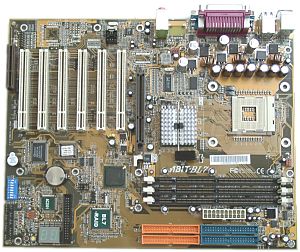 The board is quite convenient. The only disadvantage is position of audio-ins. The board carries the Abit Engineered technology. Therefore, it has two 7-segment LEDs (so that we know how loading proceeds), power and reset buttons onboard and overclocking stripes. But the latter are, for some reason, absent. Besides, there are 5 3300uF, 2 1800uF and 4 1200uF capacitors to make the board more stable in an overclocking mode. There is also an unsoldered place for a chip and tracks coming from it to unsoldered connectors with USB_AB1 and USB_CD1 writings. The IDE Raid is a rather cheap and good way to increase the performance of the disc subsystem. The switches provided will help you change processor modes, clear the CMOS etc.  The BIOS is based on the v6.00PG from Award and features the SoftMenu technology to overclock the processor. Here you can change a memory frequency in 1 MHz steps (from 100 to 250MHz), change a FSB speed, change a CPU multiplier and Vcore. You can also alter a correlation of FSB, PCI and memory frequencies. Besides, you may adjust the AGP bus and distribute interrupts among PCI slots. Such a high overclocking potential of the board doesn't prevent it from working stably at rated and higher frequencies. Test resultsWe won't comment results if they don't require it because it is just a comparison of the SiS 645 with all the rest. 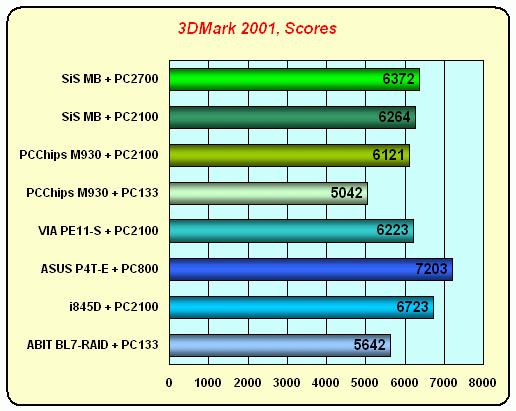 You see, the i850 holds its leading position. The PC2700 (DDR333) doesn't help much to the SiS 645: a performance gain is too little in comparison to the PC2100. Why? The RDRAM, as you know, suits well for stream operations; that is why it is easy to say whether one or another application is oriented towards such operations. Secondly, PC800 RDRAM, except PC100 and PC1600, is the only memory type which can work with the Pentium 4 in a synchronous mode. 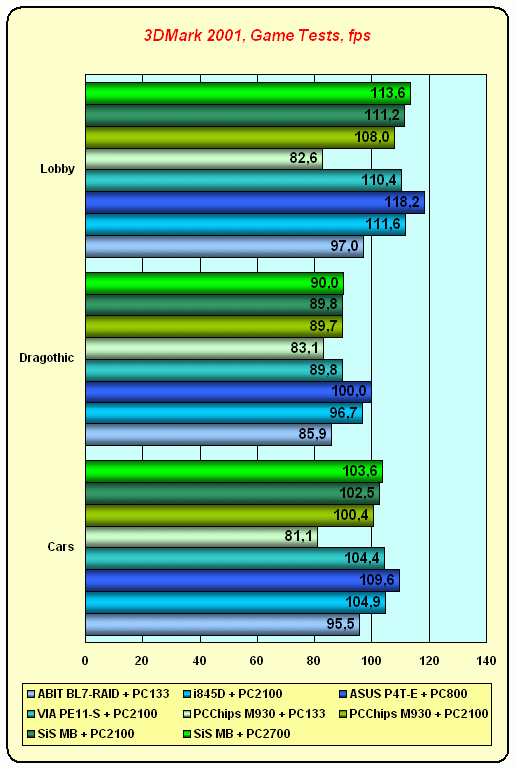 The game diagrams coincide with the overall performance in the 3DMark 2001 even from a "graphical standpoint" - the boards from the Abit BL-7 RAID (i845 + PC133) through the PCChips m930 (SiS 645 + PC133) form something like a greater-than sign, while the PCChips m930 and SiS Reference Board with both memory types form a flat plane. The results of the SiS 645 coupled with the PC133 SDR SDRAM are the lowest.  Here the SiS 645 + DDR333 look much better, it has almost caught up with the i850 + PC800 RDRAM! 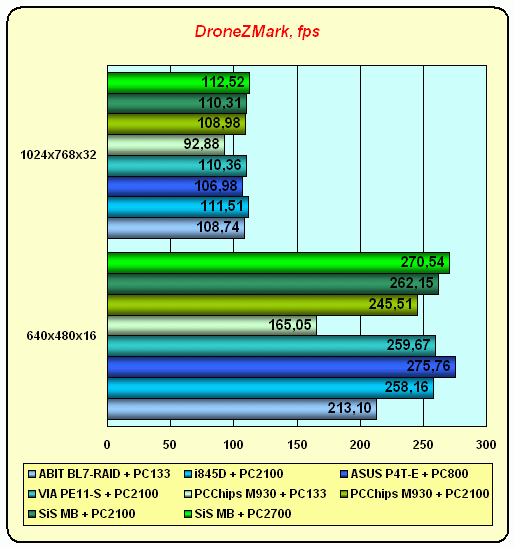 In high resolutions the outsider is SiS 645 with PC133. A speed of operation of this chipset with the SDR memory is so low that it's not enough to supply a video card with textures in time. In low resolutions in a 16-bit color mode the SiS 645 + DDR333 again go on a par with the i850. The results of the SiS 645 + PC133 in 16-bit color are not worth mentioning. Why did SiS provide support for this memory?... :)  The situation is the same as in the DroneZ 640x480x16 and it remains the same also in higher resolutions and 32-bit color. 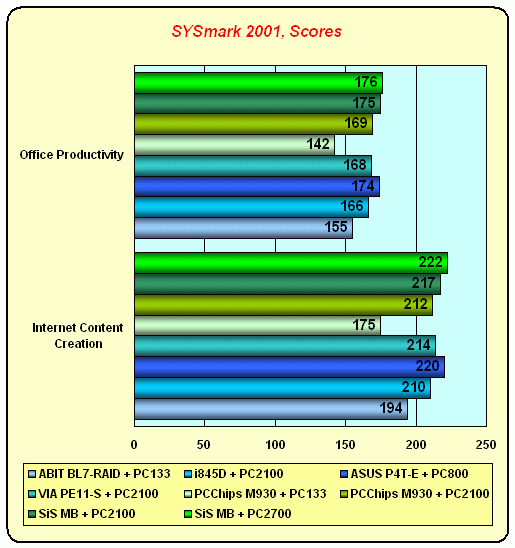 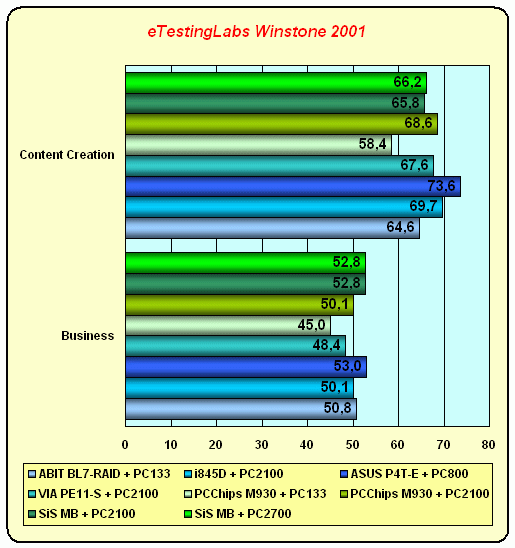 These semisynthetic tests are of the same type, but the difference is really great! In the SYSmark 2001 the SiS 645 looks excellent even with the DDR266, while the Winstone 2001 Content Creation reminds me of the 3DMark 2001. We can see the familiar greater-than sign and line, though the PCChips m930 + DDR266 have come forward. But the gap is only 3%... let's consider it just a bug. Now the Winstone 2001 Content Creation. It would have been easier if the Winstone 2001 had shown separate scores for each application, but it demonstrates only the overall result. Well, the most verisimilar assumption is that one of the programs (Adobe Photoshop 5.5 Adobe Premiere 5.1, Macromedia Director 8.0, Macromedia DreamWeaver 3.0, Netscape Navigator 4.73, Sound Forge 4.5) gives a picture identical to the 3DMark 2001, and its influence is so great that it changes all other results. The SiS 645 works better with a speedier memory. 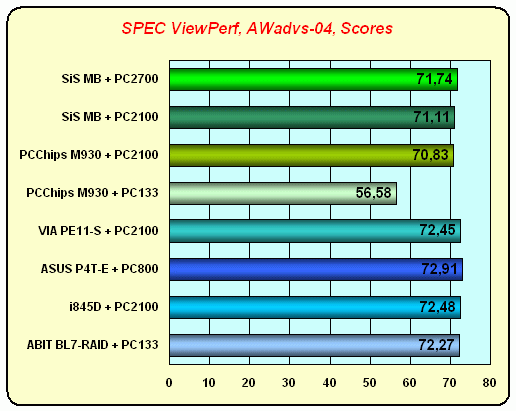 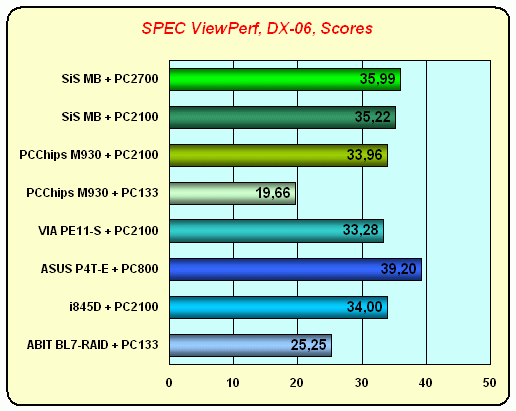 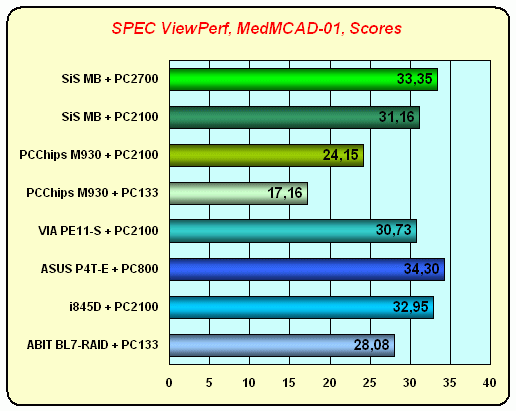 The Awadvs-04 tests a texturing speed. All platforms, but for the SiS 645, have equal results here. It is not a fault of the GART driver because the SiS 645 has an excellent performance both with the DDR266 and DDR333. Well, the conclusion is that SiS has debugged the GART driver but the SDR SDRAM controller in the SiS 645 is completely crushed. The DX-06 (IBM Data Explorer) shows the same combination of the greater-than sign and the line. The MedMACD-01 does have the greater-than sign as well, but the performance of the SiS 645 is growing up when it moves from DDR266 to DDR333, and with the fastest memory it gets very close to the i850 + RDRAM. The results of the PCChips with DDR266... let's call a spade a spade - both boards can't be debugged completely as they are so young, as well as their BIOS. 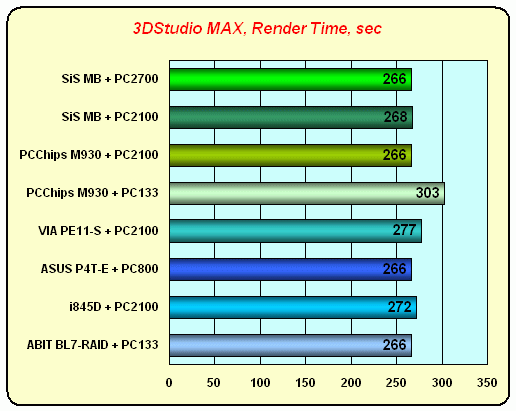 Here, a higher score is worse. The 3DStudio MAX is good only for comparison of processors with different architecture, L1/L2 cache sizes and frequency. All chipsets have equal scores except the SiS 645 + PC133. It seems that the SDR SDRAM controller is really awful, and even applications indifferent to the memory subsystem can't "neglect" this. 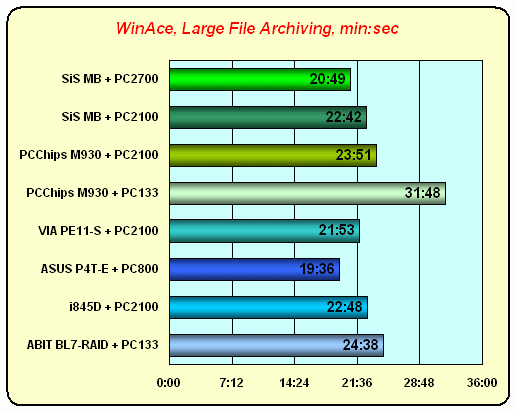 The WinAce, with its 4-MB library, is an excellent test for a memory subsystem. Therefore, the faster the memory, the better the result. The SiS 645 + DDR333 comes very close to the i850, the SiS 645 + PC133 falls into last position. Look at the i845 + PC133 SDRAM - the memory controller is quite efficient. 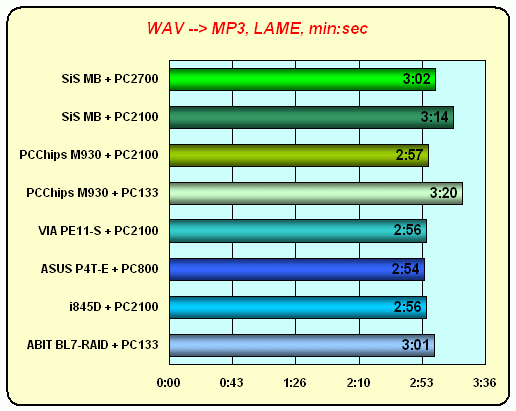 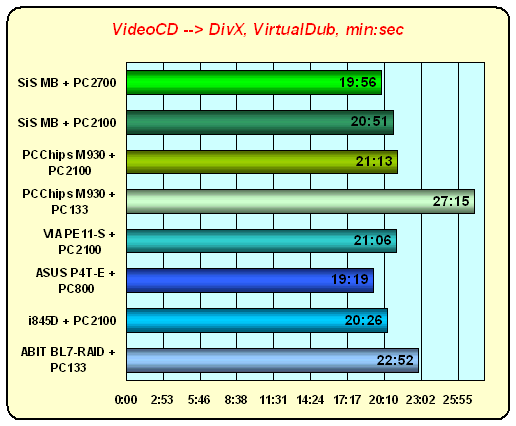 The media encoding shows a clear difference between program operation algorithms. The LAME MP3 codec does its best so that data processed wouldn't exceed a maximum memory size cached by a processor, that is why its results are similar for different chipsets. With a faster processor the encoding gets speedier. On the other hand, if the algorithm were different, platforms with a faster memory might have a higher score. The DivX codec uses an entirely different algorithm, as the results show. The i850 takes the lead, and the SiS 645 + DDR333 follows it. The VIA P4X266 strikes us with its outcome in comparison with the SiS 645 + PC133. 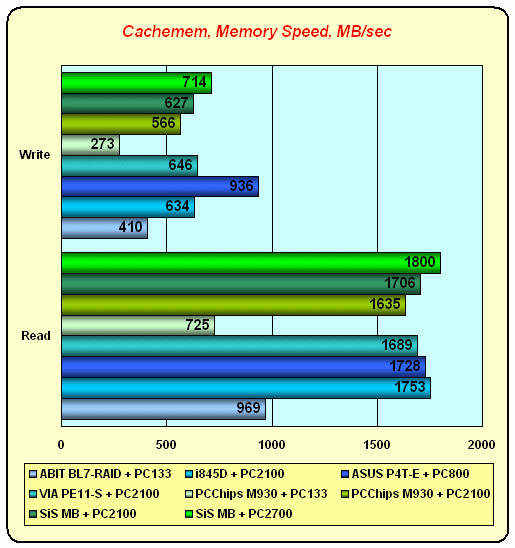 Well, here the i850 has a huge advantage over the rest as far as memory recording speed is concerned. The DDR chipset either outscore the i850 in a reading speed it comes to it very close. The i845 + PC133 outperforms the SiS 645 + PC133 in a writing speed by 50%! By the way, a high memory recording speed seems to be peculiar to the whole 800 series of Intel. The SiS 645 (+DDR) is a typical DDR chipset: speeds of the VIA P4X266, i845D, and SiS 645 are comparable. The competitors, however, do not have DDR333 support. ConclusionThe products we tested today need to be debugged.
But the wave of interest of brandname vendors to this chipset makes
me think that it lacks for considerable bugs, and a well-tweaked
board on the SiS 645 will give its owner all the highs we have found
today and release from all the downsides. The chipset is the fastest
of all alternatives to the i850 we have ever seen; besides, it is
not expensive and has a reserve for future (DDR333/PC2700 support).
We will return to this chipset again with an advent of more non-reference
board on it.
Write a comment below. No registration needed!
|
Platform · Video · Multimedia · Mobile · Other || About us & Privacy policy · Twitter · Facebook Copyright © Byrds Research & Publishing, Ltd., 1997–2011. All rights reserved. | |||||||||||||||||||||||||||||||||||||||||||||||||||||||||||||||||||||||||||||||||||||||||||||||||||||||||||||||||||||||